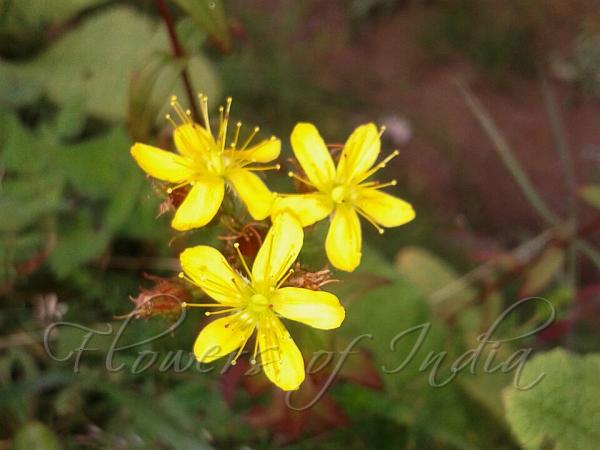|
| Himalayan Hypericum |
|

|

|
|
|
|
Photo: |
Botanical name: Hypericum elodeoides Family: Hypericaceae (Hypericum family)
Synonyms: Hypericum napaulense
Synonyms: Hypericum napaulense
Himalayan Hypericum is an erect perennial herb
with two distinct forms. One form has narrow leaves and narrow petals, the
other has very broad leaves and petals.
Stems are 15-73 cm long, sometimes from a shortly creeping rooting
base, terete, smooth, usually unbranched below inflorescence. Leaves
are stalkless, 1-3.6 cm long, 2-17 mm broad, ovate-lanceshaped,
lanceshaped or oblong-lanceolate, tip pointed to blunt or rounded,
base heart-shaped-stem-clasping to rounded, lower pairs entire,
uppermost pairs with glandular-ciliate ears and base, with
intra-marginal black glands. Flowers are borne in clusters at the top
op of the stem. Bracts have glandular-ciliate margin. Flowers are 1-1.7
cm across, yellow. Sepals are 5-9 mm long, linear to narrowly
inverted-lanceshaped, pointed, with prominent long-stalked glands on
the margins. Petals are broadly inverted-lanceshaped to obovate, 7-12
mm long, with marginal black dots and sometimes laminar black dots to
lines. Stamens are long, in fascicles. Ovary is 3-locular, 2-2.5 mm
long, styles 1.5-2.5 longer than the ovary, free, divergent, straight.
Capsule are 5-8 mm long, ovoid, longitudinally vittate. Himalayan
Hypericum is found in the Himalayas, from Kashmir to SW China and
Burma, at altitudes of 1500-3500 m. Flowering: July-September.
| Identification credit: Nongthombam Ullysess | Photographed enroute to Sela Pass, Arunachal Pradesh & Govindghat-Ghangria route, Uttarakhand. |
• Is this flower misidentified? If yes,